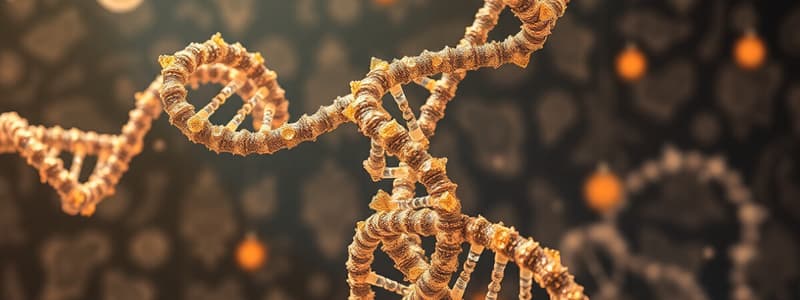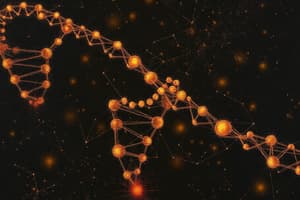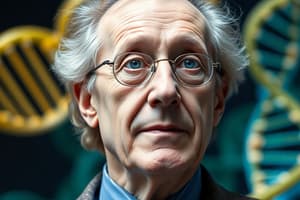Podcast
Questions and Answers
What was the main focus of Crick and Watson's research after discovering the structure of DNA?
What was the main focus of Crick and Watson's research after discovering the structure of DNA?
- Investigating protein synthesis
- Constructing viruses (correct)
- Studying RNA structures
- Developing vaccines for genetic disorders
Which scientist's work was crucial in providing data that aided Crick and Watson's model of DNA?
Which scientist's work was crucial in providing data that aided Crick and Watson's model of DNA?
- Rosalind Franklin (correct)
- Linus Pauling
- Maurice Wilkins
- Oswald Avery
How did Crick and Watson validate their model of DNA's double helix structure?
How did Crick and Watson validate their model of DNA's double helix structure?
- Recreating the DNA molecule from scratch
- Using guided theoretical models and external data (correct)
- Collaborating on clinical trials
- Conducting complex chemical experiments
What are the four chemical bases that make up DNA?
What are the four chemical bases that make up DNA?
What significant project did James Watson lead in 1989?
What significant project did James Watson lead in 1989?
What can be inferred about the relationship between Maurice Wilkins and Rosalind Franklin during their research?
What can be inferred about the relationship between Maurice Wilkins and Rosalind Franklin during their research?
What is the significance of Chargaff's findings regarding DNA bases?
What is the significance of Chargaff's findings regarding DNA bases?
What physical structure does the double helix of DNA resemble?
What physical structure does the double helix of DNA resemble?
In how many days did Crick and Watson build their final DNA model?
In how many days did Crick and Watson build their final DNA model?
What was the primary aim of Crick and Watson's research in the early 1950s?
What was the primary aim of Crick and Watson's research in the early 1950s?
What was the length of the paper published by Crick and Watson on their DNA discovery?
What was the length of the paper published by Crick and Watson on their DNA discovery?
Which significant award did Crick and Watson receive for their work in DNA structure?
Which significant award did Crick and Watson receive for their work in DNA structure?
What was the innovative method used by Crick and Watson in their research?
What was the innovative method used by Crick and Watson in their research?
What aspect of molecular biology did the discovery of DNA's double helix primarily impact?
What aspect of molecular biology did the discovery of DNA's double helix primarily impact?
What significant discovery did Francis Crick and James Watson make in 1953?
What significant discovery did Francis Crick and James Watson make in 1953?
What area did Francis Crick decide to retrain in after his initial studies in physics?
What area did Francis Crick decide to retrain in after his initial studies in physics?
In what year did Francis Crick complete his PhD?
In what year did Francis Crick complete his PhD?
What prestigious award did Francis Crick receive in 1962?
What prestigious award did Francis Crick receive in 1962?
Which laboratory did Francis Crick join to start his PhD research?
Which laboratory did Francis Crick join to start his PhD research?
What field did Crick study after moving to California in 1976?
What field did Crick study after moving to California in 1976?
Which major project did Francis Crick lead starting in 1989?
Which major project did Francis Crick lead starting in 1989?
What was one of Crick's notable roles between 1953 and 1955?
What was one of Crick's notable roles between 1953 and 1955?
What career shift did Francis Crick make after his wartime work with the Royal Navy?
What career shift did Francis Crick make after his wartime work with the Royal Navy?
What was the significant outcome of Crick and Watson's collaboration in 1953?
What was the significant outcome of Crick and Watson's collaboration in 1953?
Which institution did Francis Crick join to conduct his PhD research on X-ray diffraction?
Which institution did Francis Crick join to conduct his PhD research on X-ray diffraction?
What role did Crick take on at the Salk Institute in 1977?
What role did Crick take on at the Salk Institute in 1977?
In what year was the Nobel Prize awarded to Francis Crick for his work on DNA?
In what year was the Nobel Prize awarded to Francis Crick for his work on DNA?
Which notable project did Crick lead in 1989?
Which notable project did Crick lead in 1989?
What was a key area of research for James Watson before joining Crick at Cavendish Laboratory?
What was a key area of research for James Watson before joining Crick at Cavendish Laboratory?
What significant scientific contribution did Crick express in 1966?
What significant scientific contribution did Crick express in 1966?
How did Watson and Crick first approach the problem of modeling DNA's structure?
How did Watson and Crick first approach the problem of modeling DNA's structure?
What was a key insight derived from Chargaff's observation regarding DNA bases?
What was a key insight derived from Chargaff's observation regarding DNA bases?
Which scientific field benefited the least from Watson and Crick's discovery of the double helix structure?
Which scientific field benefited the least from Watson and Crick's discovery of the double helix structure?
What was the relationship between Rosalind Franklin and Maurice Wilkins during their research?
What was the relationship between Rosalind Franklin and Maurice Wilkins during their research?
What was unusual about the team dynamic of Watson and Crick compared to other scientists in the DNA race?
What was unusual about the team dynamic of Watson and Crick compared to other scientists in the DNA race?
Which statement accurately describes the process of DNA replication as understood by Watson and Crick?
Which statement accurately describes the process of DNA replication as understood by Watson and Crick?
What surprising outcome occurred following the publication of Watson and Crick's landmark paper?
What surprising outcome occurred following the publication of Watson and Crick's landmark paper?
What method did Watson and Crick use to validate the double helix model of DNA?
What method did Watson and Crick use to validate the double helix model of DNA?
What was one of the main consequences of discovering the structure of DNA?
What was one of the main consequences of discovering the structure of DNA?
Who was the first scientist to publicly acquire a clear image of DNA's structure?
Who was the first scientist to publicly acquire a clear image of DNA's structure?
What year did Crick and Watson complete the double helix model of DNA?
What year did Crick and Watson complete the double helix model of DNA?
What was the timeframe in which Watson and Crick made their DNA discovery?
What was the timeframe in which Watson and Crick made their DNA discovery?
Which of the following was a notable feature of the paper published by Watson and Crick?
Which of the following was a notable feature of the paper published by Watson and Crick?
What year did the Human Genome Project, led by Watson, start its groundbreaking work?
What year did the Human Genome Project, led by Watson, start its groundbreaking work?
Flashcards are hidden until you start studying
Study Notes
Francis Crick
- Francis Crick won the Nobel Prize in 1962 for his co-discovery of the structure of DNA with James Watson.
- Crick studied physics at University College London and then began graduate work there on the viscosity of water.
- During World War II, he was recruited by the Royal Navy to help develop magnetic and acoustic mines.
- After the war, he decided to retrain in biology and in 1949, he joined the Cavendish Laboratory in Cambridge and began a new PhD on the X-ray diffraction of proteins.
- He met James Watson in 1951, and they began collaborating on the molecular structure of DNA.
- Crick completed his PhD in 1954.
- He moved to California in 1976, where he studied developmental neurobiology and human consciousness.
James Watson
- James Watson won the Nobel Prize in 1962 for his co-discovery of the structure of DNA with Francis Crick.
- Watson enrolled at the University of Chicago at the age of 15.
- He gained a degree in zoology in 1947 and then in 1950 completed his PhD in virus research.
- He moved to the Cavendish Laboratory in Cambridge in 1951 where he began collaborating with Francis Crick.
- After publishing their groundbreaking paper on DNA structure, Watson moved to California briefly before returning to the Cavendish to work with Crick on virus construction.
- He lectured at Harvard and became a professor of biology in 1960.
- He led the Human Genome Project, an international program that aimed to identify and map all the genes of a human chromosome, in 1989.
DNA Discovery
- Crick and Watson's discovery that DNA is composed of a double helix structure proved to be one of the greatest scientific discoveries of the 20th century.
- DNA (deoxyribonucleic acid) is the chemical substance within cells that determines hereditary patterns in all living things.
- Working out its structure helped scientists learn how it can replicate and pass on genetic information and provided crucial insight into how genes work.
- Crick and Watson discovered the structure of DNA after only 18 months of research.
- They built their final DNA model in 3 days and published their groundbreaking work in a paper just one page long.
The Race for DNA
- A global race to discover the structure of DNA had already begun when Crick and Watson met in 1951.
- In 1944, US immunologist Oswald Avery had discovered that DNA carries genetic information, but without knowing DNA's structure, the study of heredity could not advance.
- Key players in the race were US chemist Linus Pauling, and Rosalind Franklin and Maurice Wilkins at King's College London.
- Scientists knew that DNA could pass on genetic information and make copies of itself.
- They knew that the molecule was made up of various components: a "backbone" composed of phosphoric acid and sugar, and four chemical "bases" called adenine (A), thymine (T), guanine (G), and cytosine (C).
- It was unclear how these components fit together or how the molecule could replicate.
Rosalind Franklin & Photograph 51
- Rosalind Franklin was an expert X-ray crystallographer who produced a clear image of DNA - Photograph 51 - showing its double helix structure.
- Franklin was working alongside Maurice Wilkins, but their relationship was hostile, and Wilkins showed Photograph 51 to Crick and Watson without her knowledge.
- Franklin's image helped Crick and Watson confirm the double helix and complete their model.
The Double Helix Model
- The double helix structure of DNA resembles a twisted ladder.
- The phosphoric acid and sugar strands act as the ladder's uprights.
- The paired bases form the rungs.
- Watson and Crick realized that each rung of the ladder must be composed of two bases (either A and T or C and G) bonded together.
- The order of the bases forms the code for genetic information.
- They deduced that when the ladder splits in half, often described as the molecule "unzipping," each "half ladder" bonds with newly formed DNA components to form two new genetically identical double helixes.
Sydney Brenner
- Sydney Brenner was one of the first to see Watson and Crick's DNA model.
- He produced leading research into developmental genetics and molecular biology.
- In 1961, he discovered the encoding process for the amino acids of a protein with Crick.
- Brenner is best known for his work on organ development and cell apoptosis (programmed cell death) through his study of transparent nematodes, for which he jointly received a Nobel Prize in 2002.
Impact of the Discovery
- Discovering the famous double helix structure of DNA enabled the launch of new scientific techniques, such as gene sequencing and genetic engineering.
- It also opened up vast areas of research into inherited medical conditions.
Francis Crick
- Crick and Watson made one of the most significant breakthroughs in scientific history when they determined DNA's double helix structure.
- Crick studied physics at University College London and then worked on the viscosity of water.
- He worked for the Royal Navy during World War II, later retraining in biology.
- Crick joined the Cavendish Laboratory in Cambridge in 1949, where he met Watson and started researching DNA.
- He completed his PhD in 1954 and continued his work on the genetic code.
- He moved to California in 1976, researching developmental neurobiology and human consciousness.
James Watson
- Watson's work in virus research at the University of Chicago led to his groundbreaking study of DNA.
- He studied zoology at the University of Chicago, gaining a PhD in virus research in 1950.
- Watson joined the Cavendish Laboratory in Cambridge in 1951, forming a partnership with Crick that ultimately led to the discovery of DNA's structure.
- He lectured at Harvard and became professor of biology in 1960.
- Watson led the Human Genome Project, an international scientific project aimed at identifying and mapping all human genes, in 1989.
The Race to Discover DNA
- The discovery of DNA's structure was a global race among scientists.
- Avery determined that DNA carries genetic information in 1944, but its structure remained unknown at the time.
- Linus Pauling, Rosalind Franklin, and Maurice Wilkins were among the prominent players in the race to uncover DNA's structure in the 1950s.
- Scientists recognized DNA's ability to pass on genetic information and replicate itself, knowing that the molecule consisted of a backbone of phosphoric acid and sugar, as well as four bases: adenine, thymine, guanine, and cytosine.
- The exact arrangement and function of these components remained a mystery.
Crick & Watson's Approach
- Crick and Watson focused on the investigation with unwavering determination.
- They used evidence from other scientists and combined their knowledge of viral genetics, physics, and X-ray crystallography.
- They built 3D models to replicate DNA's structure based on its chemical properties, after two unsuccessful attempts, they were able to create a successful model.
Franklin's Contribution
- Rosalind Franklin, an expert in X-ray crystallography, captured a clear image of DNA's double helix structure, known as Photograph 51.
- Despite working alongside Maurice Wilkins, their relationship was strained, and Wilkins showed Photograph 51 to Watson and Crick without her knowledge.
- The image was useful for confirming the double helix model, and the final structure was completed by Watson and Crick.
The Double Helix
- DNA's double helix structure resembles a twisted ladder, with phosphate and sugar strands forming the uprights and paired bases forming the rungs.
- The pairing of bases is significant, with adenine always bonding with thymine and guanine with cytosine.
- It is this sequence of bases that forms the genetic code.
- When the DNA molecule "unzips," each half bonds with newly formed components, creating two identical double helixes.
The DNA Discovery's Impact and Recognition
- Watson and Crick completed their model in March 1953, and their discovery was published in a groundbreaking paper in April.
- Franklin's contribution to their work was only acknowledged briefly.
- This discovery was significant as it provided a crucial understanding of genetics and advanced molecular biology.
- Watson, Crick, and Wilkins received the Nobel Prize in Physiology or Medicine in 1962 for their contributions.
Sydney Brenner
- Brenner was one of the first to see Watson and Crick's DNA model.
- After completing his PhD at Oxford, Brenner researched developmental genetics and molecular biology.
- He and Crick discovered the encoding process for protein amino acids in 1961.
- Brenner is known for his work on organ development and cell apoptosis, receiving the Nobel Prize in 2002.
DNA's Applications
- The discovery of DNA's structure led to new scientific techniques including gene sequencing and genetic engineering.
- The double helix structure opened new avenues for research related to inherited medical conditions.
Studying That Suits You
Use AI to generate personalized quizzes and flashcards to suit your learning preferences.




